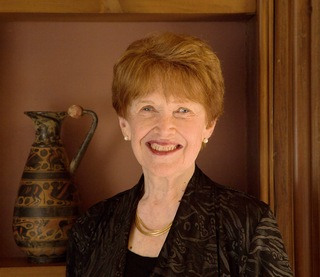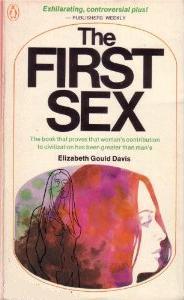
Dianic Wicca, also known as Dianic Witchcraft, is a modern pagan goddess tradition focused on female experience and empowerment. Leadership is by women, who may be ordained as priestesses, or in less formal groups that function as collectives. While some adherents identify as Wiccan, it differs from most traditions of Wicca in that only goddesses are honored.

Matriarchy is a social system in which women hold the primary power positions in roles of authority. In a broader sense it can also extend to moral authority, social privilege and control of property. While those definitions apply in general English, definitions specific to anthropology and feminism differ in some respects.
Dominator culture refers to a model of society where fear and force maintain rigid understandings of power and superiority within a hierarchical structure. Futurist and writer Riane Eisler first popularized this term in her book The Chalice and the Blade. In it, Eisler positions the dominator model in contrast to the partnership model, a more egalitarian structure of society founded on mutual respect among its inhabitants. In dominator culture, men rule over women, whereas partnership culture values men and women equally.

When God Was a Woman is the U.S. title of a 1976 book by sculptor and art historian Merlin Stone. It was published earlier in the United Kingdom as The Paradise Papers: The Suppression of Women's Rites. It has been translated into French as Quand Dieu était femme in 1978, into Dutch as Eens was God als Vrouw belichaamd – De onderdrukking van de riten van de vrouw in 1979, into German as Als Gott eine Frau war in 1989 and into Italian as Quando Dio era una donna in 2011.

The Mosuo, often called the Naxi among themselves, are a small ethnic group living in China's Yunnan and Sichuan provinces. Consisting of a population of approximately 40,000, many of them live in the Yongning region, around Lugu Lake, in Labai, in Muli, and in Yanyuan.
This is an index of articles related to the issue of feminism, women's liberation, the women's movement, and women's rights.

Johann Jakob Bachofen was a Swiss antiquarian, jurist, philologist, anthropologist, and professor for Roman law at the University of Basel from 1841 to 1845.

The Venus of Laussel is an 18.11-inch-high (46.0-centimetre) limestone bas-relief of a nude woman. It is painted with red ochre and was carved into the limestone of a rock shelter in the commune of Marquay, in the Dordogne department of south-western France. The carving is associated with the Gravettian Upper Paleolithic culture. It is currently displayed in the Musée d'Aquitaine in Bordeaux, France.

Riane Tennenhaus Eisler is an Austrian-born American systems scientist and author who writes about the effect of gender politics historically on society. She is most known for her 1987 book The Chalice and the Blade, in which she coined the terms "partnership" and "dominator".

The Goddess movement is a revivalistic Neopagan religious movement which includes spiritual beliefs and practices that emerged predominantly in the Western world during the 1970s. The movement grew as a reaction both against secularism and Abrahamic religions, which have only gods with whom are referred by male pronouns. It revolves around Goddess worship and the veneration for the divine feminine, and may include a focus on women or on one or more understandings of gender or femininity.

The First Sex is a 1971 book by the American librarian Elizabeth Gould Davis, considered part of the second wave of feminism. In the book, Gould Davis aimed to show that early human society consisted of matriarchal "queendoms" based around worship of the "Great Goddess", and characterised by pacifism and democracy. Gould Davis argued that the early matriarchal societies attained a high level of civilization, which was largely wiped out as a result of the "patriarchal revolution". She asserted that patriarchy introduced a new system of society, based on property rights rather than human rights, and worshipping a stern and vengeful male deity instead of the caring and nurturing Mother Goddess.
Ifi Amadiume is a Nigerian poet, anthropologist and essayist. She joined the Religion Department of Dartmouth College, New Hampshire, US, in 1993.
Cultural transformation theory proposes that societies used to follow a “partnership model” of civilization but over time, it gave way to today's current “dominator model” of civilization. This theory was first proposed by Riane Eisler, a cultural scholar, in her book The Chalice and the Blade. Eisler affirms that societies exist on a partnership-domination continuum but we as a species have moved away from our former partnership orientation to a more domination orientation by uplifting masculine ideals over feminine ideals. She insists that people do not have to live in a society based on the rule of one gender class over the other. There is historical evidence that another type of society, where all individuals are equal, is possible.

The Myth of Matriarchal Prehistory: Why An Invented Past Will Not Give Women a Future is a 2000 book by Cynthia Eller that seeks to deconstruct the theory of a prehistoric matriarchy. This hypothesis, she says, developed in 19th century scholarship and was taken up by 1970s second-wave feminism following Marija Gimbutas. Eller, a retired professor of religious studies at Claremont Graduate University, argues in the book that this theory is mistaken and its continued defence is harmful to the feminist agenda.

A matriarchal religion is a religion that focuses on a goddess or goddesses. The term is most often used to refer to theories of prehistoric matriarchal religions that were proposed by scholars such as Johann Jakob Bachofen, Jane Ellen Harrison, and Marija Gimbutas, and later popularized by second-wave feminism. In the 20th century, a movement to revive these practices resulted in the Goddess movement.
The Great Goddess hypothesis theorizes that, in Palaeolithic, Mesolithic, and/or Neolithic Europe and Western Asia and North Africa, a singular, monotheistic female deity was worshipped.
Feminism is one theory of the political, economic, and social equality of the sexes, even though many feminist movements and ideologies differ on exactly which claims and strategies are vital and justifiable to achieve equality.
After the Development of Agriculture (ADA) is a system for counting years forward from 8000 BCE, making 2023 the year 10023 ADA. It was developed in feminist thealogy. It is not often used.
Maxine Hammond Dashu, known professionally as Max Dashu, is an American feminist historian, author, and artist. Her areas of expertise include female iconography, mother-right cultures and the origins of patriarchy. She identifies as a lesbian.
The Chalice and The Blade: Our History, Our Future is a 1987 book by Riane Eisler. The author presents a conceptual framework for studying social systems with particular attention to how a society constructs roles and relations between the female and male halves of humanity.










